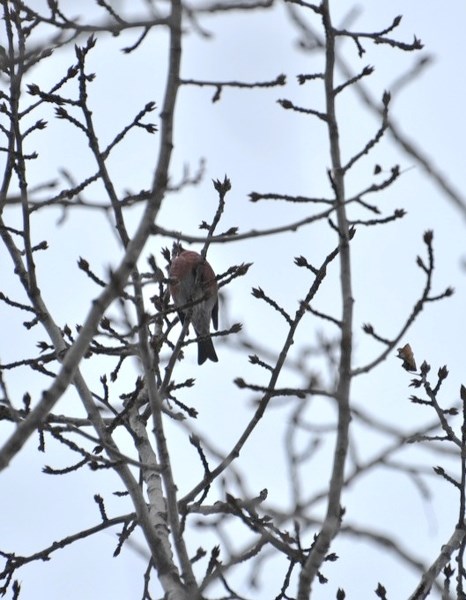The annual Athabasca Christmas Bird Count was a great success this year thanks to the collaborative efforts of observers and feeders for more than 20 km around town.
This year, participating birders spotted 27 unique species making up a total 3,052 individual birds, compared to 32 species last year making up 2,039 individual birds.
Each year, the bird count not only provides avid and amateur birders alike the opportunity to do something they enjoy outdoors, but also crucial data that helps keep track of seasonal changes in local bird populations over time.
The birders ìwere once again treated to a wonderful variety of colours and patterns that make up the diversity of our winter Boreal bird populations,î according to Harvey Scott, Athabasca Christmas Bird Count coordinator.
This year saw 13 field observers participate as part of seven parties, compared to 12 field observers in six parties in last yearís event.
ìOne of the main reasons for the greater overall numbers was a significant increase of the Red Polls, the pretty little Pine Siskins and the beautiful reddish Pine Grosbeaks and the yellowish Evening Grosbeaks.î
He said that it is good to recognize the higher numbers as an upward shift from suffering population losses in recent years due to disease.
Scott said that while the higher numbers are encouraging, there are larger environmental issues at play such as ìdeforestation and other industrial disturbancesî that effect the bird populations. No owls or hawks were spotted this year.
Even with this yearís higher numbers, few raptors and owls were spotted, as a variety of owls ñ Snowy, Great Horned, Great Gray, Barred and Boreal ñ are normally spotted.
Only two additional hours were spent counting birds this year (95 hours compared to 93 hours last year), but with the addition of cross-country skiers participating this year, the cumulative distance between birdersí traveling by car, foot and ski totaled 239 km, compared to 163 km traveled last year.
Only one Bald Eagle was spotted this year; two were spotted last year. The same number of Hairy Woodpeckers were spotted this year (33), but there was an ìeruption of Pine Grosbeaks,î according to Wayne Brehaut, a tutor at Athabasca University and member of Athabascaís Science Outreach group. The Pine Grosbeaks saw an increase from 141 in last yearís count to 405 this year, or a 187.2-per-cent increase. Scott said the eagles are one of the migratory birds they may spot in the count, but the predators can remain in the area instead of migrating south if lakes freeze late in the season, retaining one the eagleís menu items: ducks.
The overall population of bird species other than the Pine Grosbeak spotted this year increased in numbers by approximately 36.7 per cent over last yearís numbers, according to statistics submitted by Scott.
He said one ìunusualî find this year was a Robin spotted by Bruce Jackson at his feeder near the high school.
Birds such as this robin, as well as birds such as a number of Dark Eyed Juncos and Red Polls, can sometimes ìget caught hereî and stick around sometimes for the entire winter, near backyard feeders.
ìOverall, we feel the 2012 Athabasca Christmas Birdcount was a good success both in terms of numbers of birds and in terms of the passionate birders who turned out on a very cold day to observe their beloved and beautiful Boreal birds,î said Scott. ìMany thanks to all who participated in the field and at their feeders.î



